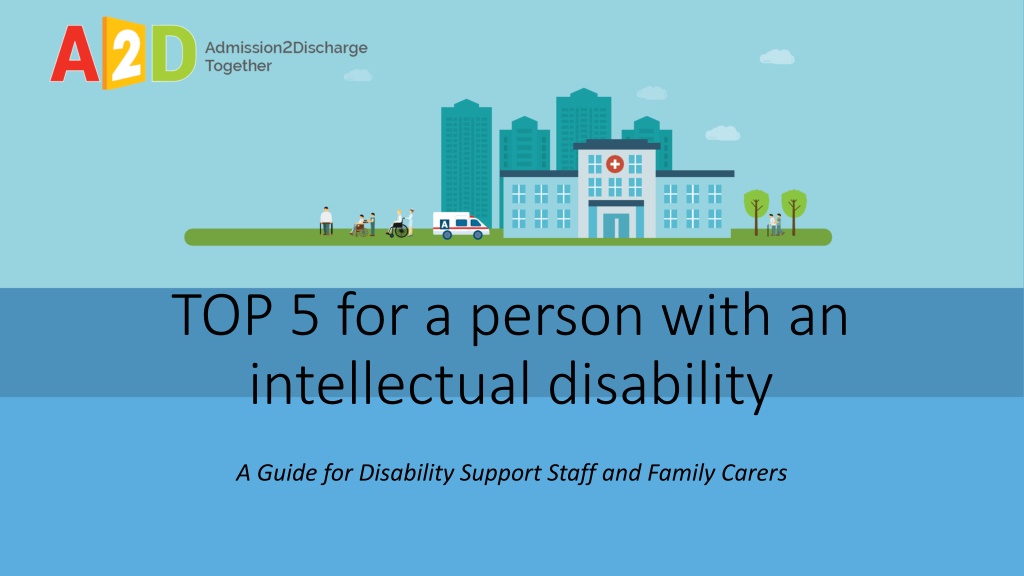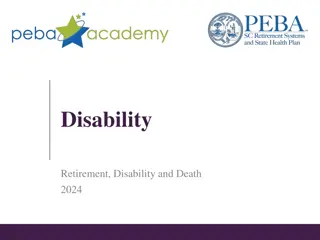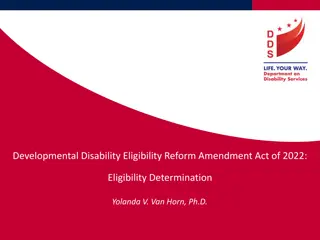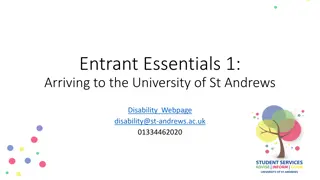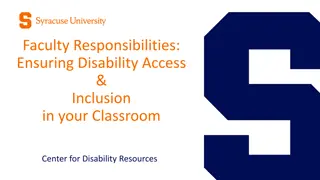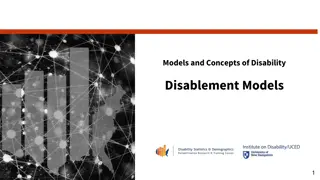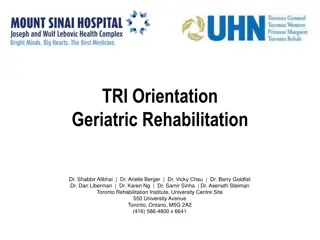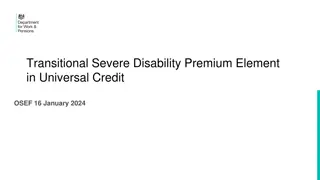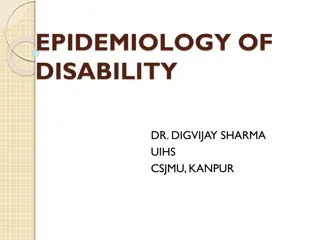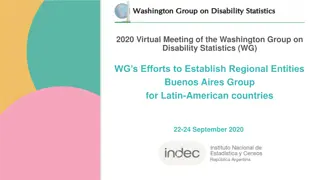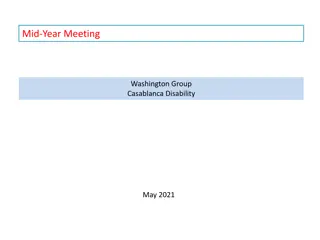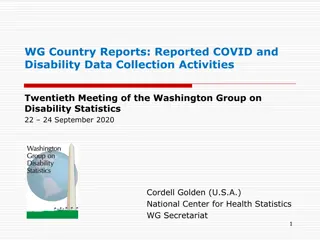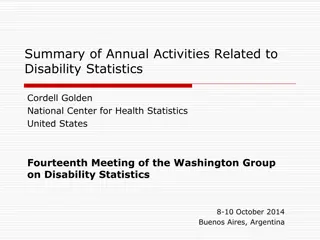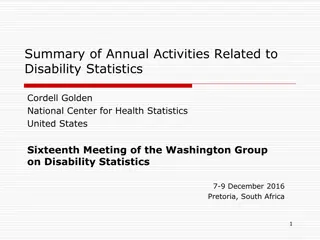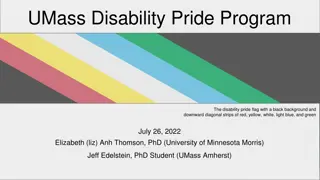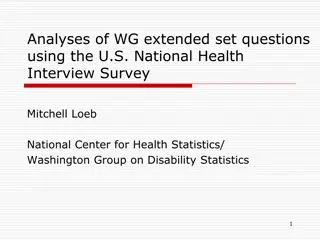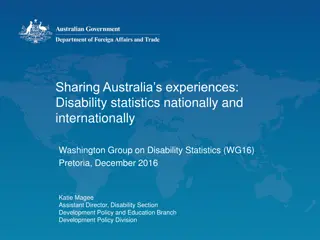Top Tips for Effective Disability Support
This guide provides essential tips for disability support staff and carers to understand and address the unique needs of individuals with intellectual disabilities. It covers strategies to identify risks, offer reassurance, promote cooperation in personal care, encourage communication, and support individual interests, ultimately enhancing the hospital journey for those with disabilities.
Download Presentation

Please find below an Image/Link to download the presentation.
The content on the website is provided AS IS for your information and personal use only. It may not be sold, licensed, or shared on other websites without obtaining consent from the author.If you encounter any issues during the download, it is possible that the publisher has removed the file from their server.
You are allowed to download the files provided on this website for personal or commercial use, subject to the condition that they are used lawfully. All files are the property of their respective owners.
The content on the website is provided AS IS for your information and personal use only. It may not be sold, licensed, or shared on other websites without obtaining consent from the author.
E N D
Presentation Transcript
TOP 5 for a person with an intellectual disability A Guide for Disability Support Staff and Family Carers
TOP 5 is designed to assist the hospital staff better understand the individual needs of the person developed by people who know the person well and include: any risks eg choking, pica interests, likes, dislikes, fears/ phobias, rituals/routines things that might trigger the person to become upset whilst in the hospital setting
What are the benefits of TOP 5 TOP 5? Better understanding of the person with disability Important information to keep the person safe Strategies to support the person if they become distressed Make it easier for hospital staff to do their job Improved hospital journey for person with disability
How to develop a TOP 5 TOP 5 Consider the five most important tips or strategies you think disability/health staff need to know to: Identify risks to the persons safety i.e choking Keep the person you care for reassured and settled Gain co-operation in personal care activities Encourage communication Acknowledge and support their interests, and sense of self
Each TIP should Each TIP should include: include: 1. What 1. What action 2. 2. W Why hy 3. The 3. The expected expected outcome action the staff need the staff need do, do, or or not not do do outcome this will achieve this will achieve
Consider risks Ways to minimise the risks? Additional information? What are they? Choking Absconding Falling Aggression etc Supervision with food Meal modification Placement of food /drink Provide bed near nurses station & supervise closely Use walker when mobilising Stand a metre away when speaking to person etc Mealtime Management Plan Behaviour Management Plan Most recent specialist review etc
Examples Mark will climb over bedrails and slide out of the end of the bed. He needs supervision 24/7.. Mother Mohammed doesn t like needles and will lash out. He needs you to make it a game, distract him, 2 people to hold his hands. He needs a reward afterwards- give him a clap. Mother Tina will eat anything including non-edibles. Take care to keep medical supplies etc. out of her reach. All meals must be supervised or she will eat the containers and cutlery. Support Worker
What can help to minimise distress? Are there set routines developed that keep the person reassured? Are there things or tasks that help settle the person? What things may cause distress? at bedtime with meals with personal care unfamiliar people noise colours words clothing visitors fear of needles doctors crowds etc a quiet place must haves e.g soft toy, buzzer, remote cup of tea/coffee turn the light of sit in a chair listen to music Preferred activity talk to someone on the phone etc
Examples If you show Hanna the procedure on yourself first, she will then let you do it for her, eg put the Blood Pressure cuff on your arm, then hers. Support worker Matthew must have a magazine that features girls such as a fashion magazine. He will tuck it under his arm and sit patiently. Sister
Understanding the person? What do you need to know about the person? What do you need to know about the person? What will the outcome be? Use of key word signs Gestures & non-verbal cues How the person expresses pain, discomfort, fear Behaviours that may be used to communicate a need Use of communication aids Likes and dislikes Personality To build rapport with the person Improve communication and understanding Improve the persons experience
Examples Jonathon has a unique sign for YES: He taps his head with a closed fist. Mother Brett clicks his tongue when he is thirsty, and he squeals when he smells food. Father Sophie has a big personality and is fun loving. She likes lots of attention and positive verbal praise. Give her a 5 min warning and rephrase rather than saying No . Father
Examples Tristan is non-verbal, and uses about 20 key word signs and gestures. He will give you a thumbs up when he is happy. Father Saanvi uses Nappies, and is toilet timed. She will tap her groin if she needs to go to the toilet. You need to monitor her bowel movements as she can smear faeces. Mother
NEXT NEXT Write them on the TOP 5 form
Keep it in the A2D Together Folder Front Cover Contacts/Photo Medication Chart Blister pack/liquids/inhalers TOP 5 Tips for support Hospital Support Plan Other management plans to support the person in hospital
When admitted to hospital TOP 5 is: A copy is given to hospital staff TOP 5 is kept with the person at all times in their A2D folder TOP 5 provides important information to hospital staff who will be interacting with the person during their admission to hospital
What happens in an emergency? Give the A2D Together Folder to the Paramedic Explain the TOP 5 VITAL information for ALL health staff TOP 5 is especially important if the person is unaccompanied.
Want to know more? http://www.cclhd.health.nsw.gov.au/patientsand visitors/CarerSupport/top5 http://www.cec.health.nsw.gov.au/programs/part nering-with-patients/top5
